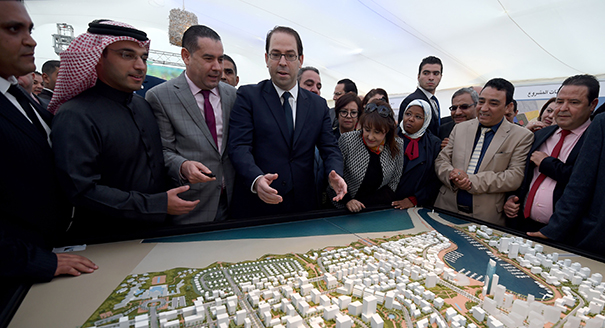On June 20 and 21, the Tunis Investment Forum, an international event organized by the Foreign Investment Promotion Agency, a Tunisian governmental organization, was a reminder of how foreign investment has become the Achilles’ heel of Tunisia’s economy.
This forum reflected Tunisia’s persistent efforts to reverse a trend that accelerated after the 2010–2011 uprising, namely the decline in foreign investments, which have failed to return to pre-uprising levels. Indeed, annual foreign direct investment (FDI) averaged the equivalent of $1.35 billion in each of the five years before the fall of president Zine al-Abedin bin Ali’s regime, and $1 billion in each of the five years after it. The declines were even sharper in 2016 and 2017, with annual FDI falling to $885 million and $880 million, respectively, before rising again in 2018 to $945 million.
Since 2014, Tunisian governments have been struggling unsuccessfully to recast Tunisia as a major destination for foreign investment. They realize that the fall in FDI widens macroeconomic imbalances and slows the economic recovery that the country desperately needs to create jobs and reduce social tensions. The fall in FDI contributed to an increase in the budget deficit from 2.6 percent of GDP in 2010 to 4.8 percent in 2018, while the public debt has increased from 44.5 percent of GDP in 2013 to 70 percent in 2018. Employment has remained a high 15.5 percent since 2015. Tunisia’s balance of payments situation deteriorated as its capacities to generate foreign currency earnings declined rapidly after the uprising. The collapse of tourism because of terrorist attacks and the increase in capital flight have also dramatically reduced foreign currency reserves. These fell from $9.8 billion in 2010 to $4.8 billion in 2018, putting downward pressure on the Tunisian dinar and leading to a higher inflation rate.
Despite promotional endeavors, post-2014 governments haven’t succeeded in boosting FDI. Confidence has been negatively affected by Tunisia’s political and economic turbulence since 2010–2011. Among the country’s efforts, parliament passed a new investment law in 2017 as part of a package of economic reforms negotiated with the International Monetary Fund and the European Union, in return for external loans and financial assistance to cover the budget and current account deficits. The law, which is designed to stimulate foreign investment, simplifies legal procedures to set up projects, reduces the number of activities requiring government authorization, and makes it easier for foreign companies to recruit highly qualified foreigners and transfer their profits out of Tunisia.
Along with the adoption of this law, the same year the government created the Tunisian Investment Authority, a new administrative body in charge of speeding up the implementation of investments. However, these measures have been insufficient in reversing the decline in FDI, showing that the problem goes deeper and cannot be resolved simply by drafting new investment laws.
Tunisia offers many advantages for foreign investors. The country enjoys a strategic geographic location on the Mediterranean, with the potential of becoming an entrance into African markets. It also has a well-educated workforce with competitive salary levels. However, because of its poor transportation infrastructure and facilities, Tunisia lags behind its North African neighbors in this regard.
In addition, despite its achievements in building its democracy, Tunisia needs to consolidate the rule of law and create an attractive investment climate that would strengthen investors’ confidence. Despite gaining eight places in the World Bank’s Ease of Doing Business Ranking of 2019, where it is 80th, Tunisia remains far behind Morocco, its major regional competitor.
More fundamentally, Tunisia needs to reassess its position in an increasingly competitive global market for FDI. The country’s over-dependency on southern European countries should encourage decisionmakers to rethink Tunisia’s international approach in order to attract FDI from other countries. Indeed, since the 1990s many European companies have outsourced or delocalized their activities to Eastern Europe and, increasingly, to emerging Asian economies, but not to Tunisia or other southern Mediterranean countries.
France, Italy, and to a lesser extent Germany are the main European investors in Tunisia. However, the economic slowdown of southern European economies since the Eurozone crisis of 2008 has negatively impacted the country. That is why Tunisia will have to reduce its reliance on these sluggish economies and diversify its economic relationships. In 2018, almost half of investments went into the oil and gas sector, followed by the electrical, automotive components, and manufacturing sectors. Tunisia also needs to attract investments with high technological value to the business services, software, information technology, and automotive sectors. This would foster the transfer of advanced technologies and consolidate diversification in the economy that would result in balanced economic growth driven by a variety of economic sectors. Any strategy to secure foreign investment should also aim to have a social impact that meets the expectations of the population, especially in Tunisia’s marginalized interior regions. Indeed, the high concentration of FDI in Tunis and the coastal regions has proven socially and politically unsustainable.
Tunisia’s decisionmakers need to articulate a comprehensive investment strategy that targets industry, trade, and human development. This will likely be at the top of the agenda of the new government that is expected to be formed following elections near the end of this year, which will be charged with ensuring greater social and political stability. Such an approach would be crucial to returning to the pre-uprising levels of FDI.






